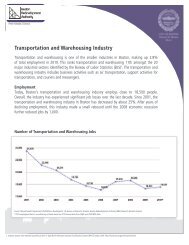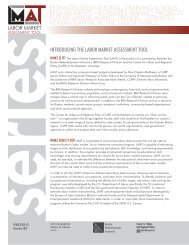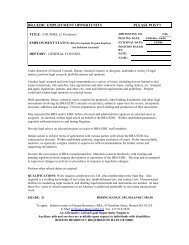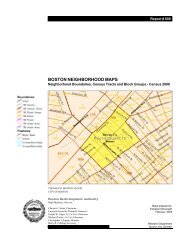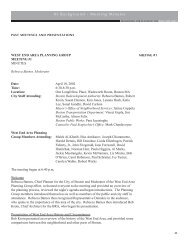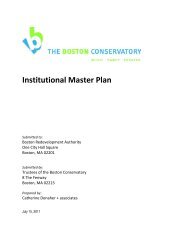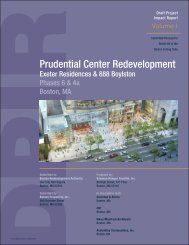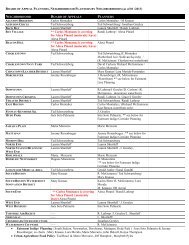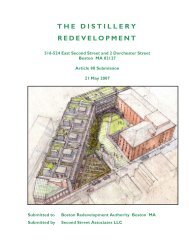point cover jan 13 - Boston Redevelopment Authority
point cover jan 13 - Boston Redevelopment Authority
point cover jan 13 - Boston Redevelopment Authority
You also want an ePaper? Increase the reach of your titles
YUMPU automatically turns print PDFs into web optimized ePapers that Google loves.
\\MABOS\projects\1<strong>13</strong>81.00\reports\Article80\<br />
Expanded_PNF\04_Environmental_FINAL.do<br />
c<br />
Vanasse Hangen Brustlin, Inc.<br />
The Point, <strong>Boston</strong><br />
federal and state databases and municipal files regarding the use, storage or release of OHM on or near the<br />
subject property. As part of the Phase II investigation, chemical testing of groundwater was performed. In<br />
summary, the Phase I/II assessments did not indicate the presence of Recognized Environmental Conditions<br />
(RECs) with respect to the subject property.<br />
It is currently anticipated that construction of the proposed building will require excavation and off-site<br />
disposal of an unknown quantity of existing soil. Disposal of excavated soil will be conducted in accordance<br />
with the current policies of the Massachusetts DEP. Chemical testing will be performed as needed to reuse/<br />
dispose of the soils off-site depending on the acceptance criteria of specific facilities.<br />
In addition, procurement of a temporary groundwater dewatering discharge permit from the Environmental<br />
Protection Agency (EPA), DEP, and <strong>Boston</strong> Water and Sewer Commission will be required for pumping and<br />
discharge of site groundwater from within the steel sheetpile cofferdam to be installed prior to excavation.<br />
Noise<br />
The purpose of the noise evaluation is to assess potential Project-related noise associated with potential<br />
rooftop mechanical equipment and loading activities. The noise analysis included noise monitoring to<br />
determine existing sound levels and calculations of future sound levels associated with potential mechanical<br />
equipment. The following section discusses noise background, the City of <strong>Boston</strong>’s noise standards, noise<br />
analysis methodology, and a comparison to the City’s noise criteria.<br />
<br />
Summary of Key Findings<br />
The noise analysis determined that the maximum sound levels that the Project may generate comply with the<br />
City of <strong>Boston</strong>’s noise standards at the sensitive receptor locations. The Project will not generate noise levels<br />
that exceed the City’s noise criteria during the daytime and nighttime period, respectively. The rooftop<br />
mechanical equipment has been strategically located on the roof in a mechanical room of the proposed<br />
building (Levels 23 and 24). Additionally, during the selection process of the rooftop mechanical equipment,<br />
the Proponent will select equipment (including any necessary mitigation measures) that would result in<br />
sound levels that do not exceed the maximum sound levels determined in this evaluation. Since majority of<br />
the service and loading activities will be serviced on-site and within the proposed building, noise impacts to<br />
the sensitive receptor locations will be negligible.<br />
<br />
Noise Background<br />
Noise is defined as unwanted or excessive sound. Sound becomes unwanted when it interferes with normal<br />
activities such as sleep, work, or recreation. How people perceive sound depends on several measurable<br />
physical characteristics. These factors include:<br />
Intensity - Sound intensity is often equated to loudness.<br />
4-28 Environmental Protection



